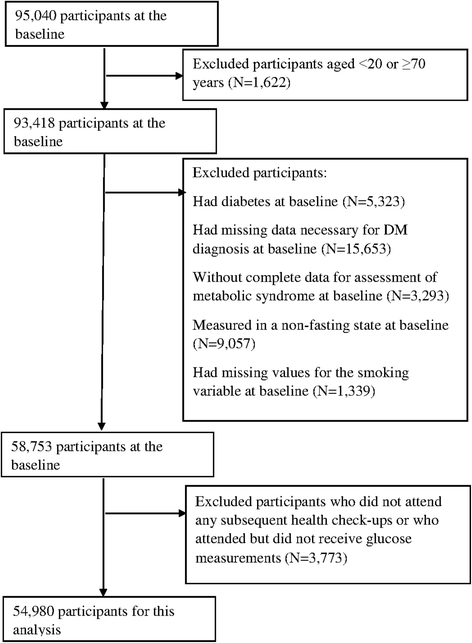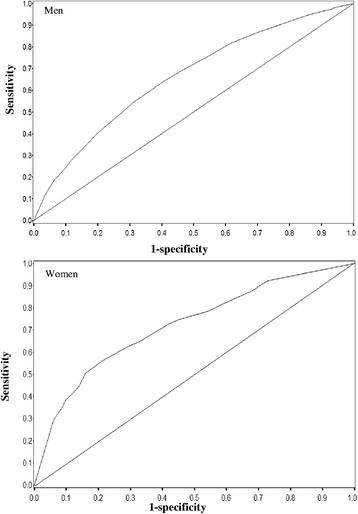Optimal waist circumference cut-off points and ability of different metabolic syndrome criteria for predicting diabetes in Japanese men and women: Japan Epidemiology Collaboration on Occupational Health Study
- PMID: 26939609
- PMCID: PMC4778284
- DOI: 10.1186/s12889-016-2856-9
Optimal waist circumference cut-off points and ability of different metabolic syndrome criteria for predicting diabetes in Japanese men and women: Japan Epidemiology Collaboration on Occupational Health Study
Abstract
Background: We sought to establish the optimal waist circumference (WC) cut-off point for predicting diabetes mellitus (DM) and to compare the predictive ability of the metabolic syndrome (MetS) criteria of the Joint Interim Statement (JIS) and the Japanese Committee of the Criteria for MetS (JCCMS) for DM in Japanese.
Methods: Participants of the Japan Epidemiology Collaboration on Occupational Health Study, who were aged 20-69 years and free of DM at baseline (n = 54,980), were followed-up for a maximum of 6 years. Time-dependent receiver operating characteristic analysis was used to determine the optimal cut-off points of WC for predicting DM. Time-dependent sensitivity, specificity, and positive and negative predictive values for the prediction of DM were compared between the JIS and JCCMS MetS criteria.
Results: During 234,926 person-years of follow-up, 3180 individuals developed DM. Receiver operating characteristic analysis suggested that the most suitable cut-off point of WC for predicting incident DM was 85 cm for men and 80 cm for women. MetS was associated with 3-4 times increased hazard for developing DM in men and 7-9 times in women. Of the MetS criteria tested, the JIS criteria using our proposed WC cut-off points (85 cm for men and 80 cm for women) had the highest sensitivity (54.5 % for men and 43.5 % for women) for predicting DM. The sensitivity and specificity of the JCCMS MetS criteria were ~37.7 and 98.9 %, respectively.
Conclusion: Data from the present large cohort of workers suggest that WC cut-offs of 85 cm for men and 80 cm for women may be appropriate for predicting DM for Japanese. The JIS criteria can detect more people who later develop DM than does the JCCMS criteria.
Figures
References
-
- Grundy SM, Cleeman JI, Daniels SR, Donato KA, Eckel RH, Franklin BA, et al. Diagnosis and management of the metabolic syndrome: an American Heart Association/National Heart, Lung, and Blood Institute Scientific Statement. Circulation. 2005;112:2735–52. doi: 10.1161/CIRCULATIONAHA.105.169404. - DOI - PubMed
Publication types
MeSH terms
LinkOut - more resources
Full Text Sources
Other Literature Sources
Medical



